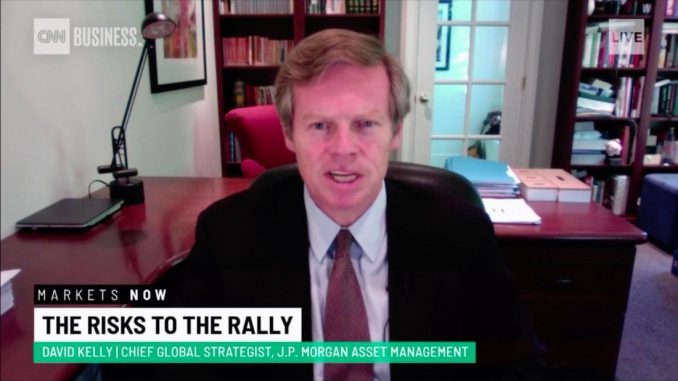
Although the US economy has shown signs of improvement in recent weeks as lockdown restrictions have eased, millions of Americans are still seeking unemployment.
Another 1.5 million workers filed for first-time jobless benefits last week — a decline of only 58,000 from the week before — the Department of Labor said Thursday. Initial claims have been falling every week since peaking at 6.9 million in the last week of March. Economists think this means that most job losses due to the pandemic are behind us.
But the slowing pace of the decline is disheartening.
First-time claims have been falling every week since peaking at 6.9 million at the end of March, but last week’s decline was by far the narrowest.
Overall, more than 45 million Americans have now filed for first-time benefits since mid-March.
Stripping out the seasonal adjustments, initial claims stood at 1.4 million last week. These adjustments smooth out the data in normal times but add unnecessary noise in this unprecedented situation.
Continuing claims, which count people who filed for benefits for at least two weeks in a row, stood at 20.5 million, only slightly down from 20.6 million in the prior week. Experts are looking for this number to come down substantially over the summer. If it doesn’t, it could mean that the labor market recovery is much slower than hoped.
“The prolonged plateau of over 20 million continuing to claim UI benefits despite states reopening sends a strong signal that any labor market recovery will happen in fits and starts,” said Glassdoor Senior Economist Daniel Zhao in an email.
But the path to recovery is littered with obstacles including federal support for businesses and workers running out, as well as a resurgence of infections.
On top of the regular unemployment benefits, nearly 2.3 million people have filed first-time claims for pandemic unemployment assistance over the past three weeks. Congress created the pandemic program to cover independent contractors, the self-employed, gig workers and certain people affected by coronavirus.
In 44 states, the overall number of people continuing to claim benefits in the program slipped to nearly 9.3 million for the week ending May 30. That’s down from 9.7 million individuals the week prior.
In addition, nearly 1.1 million people in 35 states are claiming “pandemic emergency unemployment compensation benefits,” which lawmakers created to provide those who have exhausted their benefits with an additional 13 weeks of payments. That’s more than double the week before.
Both programs, which are fully paid for with federal funds, run through the end of the year.
In total, just over 29 million people are claiming unemployment benefits in all state and federal programs.
Three months into the outbreak, many Americans are still waiting for their unemployment benefits.
Hundreds of people lined up for in-person help in Kentucky this week, for example.
The state began offering these services as the coronavirus stay-at-home restrictions eased, Gov. Andy Beshear said Wednesday. It added a new location for Thursday and Friday after reaching capacity for assistance near the Capitol building for two days.
In another sign of how long Kentuckians have been in limbo, Beshear said there will be a separate line on Thursday for those who filed claims in March, and on Friday for those submitted applications in March and April. Additional times and locations are being worked out.
In Kentucky, the number of first-time jobless claims amounted to nearly 47% of the pre-pandemic workforce. Only Georgia exceeds that figure.
The deluge of claims is also draining state unemployment trust funds, forcing them to borrow from the federal government to pay their share of benefits, which usually last 26 weeks. The jobless are guaranteed to get their payments regardless of where the money comes from.
New York and California have each borrowed about $2.1 billion, while Texas has borrowed $248 million.
Ohio received a loan for the first time during this crisis, taking out $6.1 million. The state has requested authorization to borrow up to $3.1 billion.
“That total exceeds what we think we will need to pay out in benefits. It is essentially a line of credit, so we asked for greater authority than we currently think that we will need so that we have it just in case we need it,” Governor Mike DeWine said Tuesday.
Economic data has been painting a murky picture over the past several weeks.
On the one hand, things are clearly improving: the May jobs report was far better than expected and retail sales also roared back this month. The data indicates that things are improving as states are reopening and people are recovering from the initial shock of the lockdown and the public health crisis.
That not withstanding, millions of people remain unemployed. More than 20 million jobs vanished at the height of the lockdown and it will take time to rebuild the labor market. Meanwhile, the number of Covid-19 infections is rising in some states, putting the reopening in jeopardy.
Federal Reserve Chairman Jerome Powell reiterated during is Congressional Testimony earlier this week that the pace and strength of the recovery remained uncertain. Powell also said the central bank, as well as the government, might need to do more to support the economy, its workers and those hit hardest by the pandemic recession. The Fed has stressed that minority groups including black, Hispanic and female workers have been overpresented in bearing the brunt of the crisis.
More than 100 economists, including former Federal Reserve Chairwoman Janet Yellen and Chairman Ben Bernanke, sent a letter to Congress urging the government to deploy more stimulus.
*story by CNN